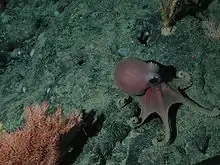Graneledone boreopacifica
Graneledone boreopacifica is an octopus in the family Megaleledonidae. It can be found in both the Pacific and the Atlantic Oceans.
| Graneledone boreopacifica | |
|---|---|
 | |
| G. boreopacifica on the Davidson Seamount at 1,973 m (6,473 ft) m depth | |
| G. boreopacifica at a depth of 2,405 m (7,890 ft) | |
| Scientific classification | |
| Domain: | Eukaryota |
| Kingdom: | Animalia |
| Phylum: | Mollusca |
| Class: | Cephalopoda |
| Order: | Octopoda |
| Family: | Megaleledonidae |
| Genus: | Graneledone |
| Species: | G. boreopacifica |
| Binomial name | |
| Graneledone boreopacifica Nesis, 1982 | |
| Synonyms | |
| |
Description
The holotype of this species measures 9 cm in mantle length.[2]
A female Graneledone boreopacifica was observed in the Monterey Canyon by the Monterey Bay Aquarium Research Institute, brooding her eggs for a record 53 months, making this the longest brooding or pregnancy period known in the animal kingdom. This also makes it the longest-living octopus – most octopuses only live for 1 or 2 years – which this octopus beats with its brooding period alone.[3][4] Female Graneledone boreopacifica tend to brood their eggs between the depths of 1,200 and 2,000 m; the eggs were never unattended.[5]
Examination of the gut of this octopus revealed significant amounts of crushed gastropod shells (Provanna variabilis and Lepetodrilus fucensis). The mandible muscles exhibit remarkable strength to crush the shells before digestion.[6]
Distribution and habitat
Graneledone boreopacifica is found in benthic zones in temperate climates.[7]
Taxonomy
The type specimen was collected in the Pacific Ocean (50°N, 151°E) and is deposited at the Zoological Institute in Saint Petersburg, Russia.[8]
References
- Allcock, L.; Allen, G. (2018). "Graneledone boreopacifica". IUCN Red List of Threatened Species. 2018: e.T163292A994368. doi:10.2305/IUCN.UK.2018-2.RLTS.T163292A994368.en. Retrieved 21 April 2023.
- Hochberg, F.G. 1998. Class Cephalopoda. In: P.V. Scott & J.A. Blake (Eds.) Taxonomic Atlas of the Benthic Fauna of the Santa Maria Basin and the Western Santa Barbara Channel: Vol. 8. Santa Barbara, California, Santa Barbara Museum of Natural History.
- Chung, Emily (30 July 2014). "Octopus mom waits record 4.5 years for eggs to hatch". CBC News. Retrieved 30 July 2014.
- Robison, Bruce; Seibel, Brad; Drazen, Jeffrey (2014-07-30). "Deep-Sea Octopus (Graneledone boreopacifica) Conducts the Longest-Known Egg-Brooding Period of Any Animal". PLOS ONE. 9 (7): e103437. Bibcode:2014PLoSO...9j3437R. doi:10.1371/journal.pone.0103437. ISSN 1932-6203. PMC 4116195. PMID 25075745.
- Robison, Bruce; Seibel, Brad; Drazen, Jeffrey (2014). "Deep-Sea Octopus (Graneledone boreopacifica) Conducts the Longest-Known Egg-Brooding Period of Any Animal". PLOS ONE. 9 (7): e103437. doi:10.1371/journal.pone.0103437. ISSN 1932-6203. PMC 4116195. PMID 25075745.
- Voight, Janet R. (November 2000). "A deep-sea octopus (Graneledone cf. boreopacifica) as a shell-crushing hydrothermal vent predator". Journal of Zoology. 252 (3): 335–341. doi:10.1111/j.1469-7998.2000.tb00628.x. ISSN 1469-7998.
- Palomares ML, Pauly D, eds. (2023). "Graneledone boreopacifica" in SeaLifeBase. April 2023 version.
- Current Classification of Recent Cephalopoda
External links
 Media related to Graneledone boreopacifica at Wikimedia Commons
Media related to Graneledone boreopacifica at Wikimedia Commons- "CephBase: Graneledone boreopacifica". Archived from the original on 2005-08-17.
